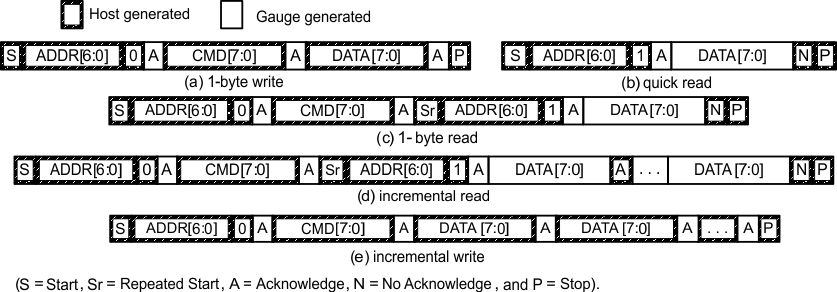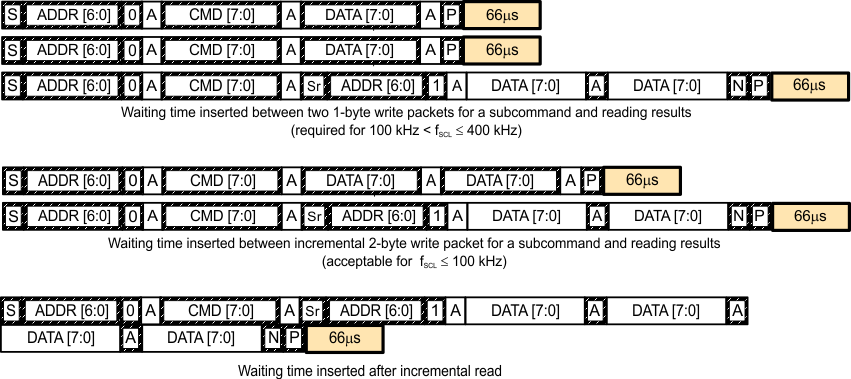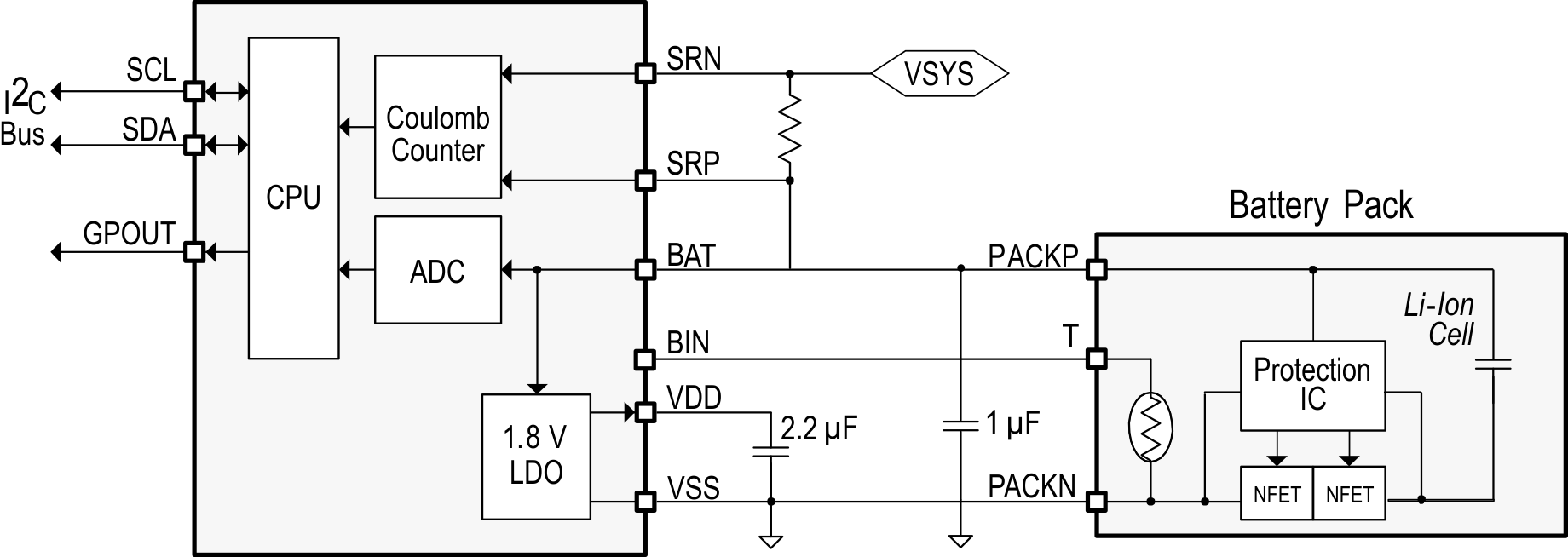ZHCSEX1A March 2016 – April 2016
PRODUCTION DATA.
- 1 特性
- 2 应用
- 3 说明
- 4 修订历史记录
- 5 Pin Configuration and Functions
-
6 Specifications
- 6.1 Absolute Maximum Ratings
- 6.2 ESD Ratings
- 6.3 Recommended Operating Conditions
- 6.4 Thermal Information
- 6.5 Supply Current
- 6.6 Digital Input and Output DC Characteristics
- 6.7 LDO Regulator, Wake-up, and Auto-Shutdown DC Characteristics
- 6.8 LDO Regulator, Wake-up, and Auto-shutdown AC Characteristics
- 6.9 ADC (Temperature and Cell Measurement) Characteristics
- 6.10 Integrating ADC (Coulomb Counter) Characteristics
- 6.11 I2C-Compatible Interface Communication Timing Characteristics
- 6.12 SHUTDOWN and WAKE-UP Timing
- 6.13 Typical Characteristics
- 7 Detailed Description
- 8 Application and Implementation
- 9 Power Supply Recommendation
- 10Layout
- 11器件和文档支持
- 12机械、封装和可订购信息
7 Detailed Description
7.1 Overview
The bq27220 fuel gauge accurately predicts the battery capacity and other operational characteristics of a single Li-based rechargeable cell. It can be interrogated by a system processor to provide cell information such as state-of-charge (SoC). The bq27220 monitors charge and discharge activity by sensing the voltage across a small value resistor (10 mΩ typical) between the SRP and SRN pins and in series with the battery. By integrating charge passing through the battery, the battery’s SOC is adjusted during battery charge or discharge.
The fuel gauging is derived from the Compensated End of Discharge Voltage (CEDV) method, which uses a mathematical model to correlate remaining state of charge (RSOC) and voltage near to the end of discharge state. This requires a full discharge cycle for a single point FCC update. The implementation models cell voltage (OCV) as a function of battery state of charge (SOC), temperature, and current. The impedance is also a function of SOC and temperature, all of which can be satisfied by using seven parameters: EMF, C0, R0, T0, R1, TC, C1.
NOTE
The following formatting conventions are used in this document:
Commands: italics with parentheses() and no breaking spaces, for example, Control().
Data Flash: italics, bold, and breaking spaces, for example, Design Capacity.
Register bits and flags: italics with brackets [ ], for example, [TDA]
Data flash bits: italics, bold, and brackets [ ], for example, [LED1]
Modes and states: ALL CAPITALS, for example, UNSEALED mode.
7.3 Feature Description
Information is accessed through a series of commands called Standard Commands. Further capabilities are provided by the additional Extended Commands set. Both sets of commands, indicated by the general format Command), are used to read and write information within the control and status registers, as well as its data locations. Commands are sent from the system to the gauge using the I2C serial communications engine, and can be executed during application development, system manufacture, or end-equipment operation.
The fuel gauge measures the charging and discharging of the battery by monitoring the voltage across a small-value sense resistor. When a cell is attached to the fuel gauge, cell impedance is computed based on cell current, cell open-circuit voltage (OCV), and cell voltage under loading conditions.
The fuel gauge uses an integrated temperature sensor for estimating cell temperature. Alternatively, the host processor can provide temperature data for the fuel gauge.
For more details, see the bq27220 Technical Reference Manual (SLUUBD4).
The external temperature sensing is optimized with the use of a high accuracy negative temperature coefficient (NTC) thermistor with R25 = 10.0 kΩ ±1%. B25/85 = 3435K ± 1% (such as Semitec NTC 103AT) on the BIN pin. Alternatively, the bq27220 can also be configured to use its internal temperature sensor or receive temperature data from the host processor. The bq27220 uses temperature to monitor the battery-pack environment, which is used for fuel gauging and cell protection functionality.
7.3.1 Communications
7.3.1.1 I2C Interface
The fuel gauge supports the standard I2C read, incremental read, quick read, one-byte write, and incremental write functions. The 7-bit device address (ADDR) is the most significant 7 bits of the hex address and is fixed as 1010101. The first 8 bits of the I2C protocol are, therefore, 0xAA or 0xAB for write or read, respectively.
 Figure 6. I2C Interface Read and Write Functions
Figure 6. I2C Interface Read and Write Functions
The quick read returns data at the address indicated by the address pointer. The address pointer, a register internal to the I2C communication engine, increments whenever data is acknowledged by the fuel gauge or the I2C master. “Quick writes” function in the same manner and are a convenient means of sending multiple bytes to consecutive command locations (such as two-byte commands that require two bytes of data).
The following command sequences are not supported:
 Figure 7. Attempt to Write a Read-Only Address (NACK After Data Sent By Master)
Figure 7. Attempt to Write a Read-Only Address (NACK After Data Sent By Master)
 Figure 8. Attempt to Read an Address Above 0x6B (NACK Command)
Figure 8. Attempt to Read an Address Above 0x6B (NACK Command)
7.3.1.2 I2C Time Out
The I2C engine releases both SDA and SCL if the I2C bus is held low for 2 seconds. If the fuel gauge is holding the lines, releasing them frees them for the master to drive the lines. If an external condition is holding either of the lines low, the I2C engine enters the low-power SLEEP mode.
7.3.1.3 I2C Command Waiting Time
To ensure proper operation at 400 kHz, a t(BUF) ≥ 66 μs bus-free waiting time must be inserted between all packets addressed to the fuel gauge. In addition, if the SCL clock frequency (fSCL) is > 100 kHz, use individual 1-byte write commands for proper data flow control. Figure 9 shows the standard waiting time required between issuing the control subcommand the reading the status result. For read-write standard commands, a minimum of 2 seconds is required to get the result updated. For read-only standard commands, there is no waiting time required, but the host must not issue any standard command more than two times per second. Otherwise, the gauge could result in a reset issue due to the expiration of the watchdog timer.
 Figure 9. Standard Waiting Time
Figure 9. Standard Waiting Time
7.3.1.4 I2C Clock Stretching
A clock stretch can occur during all modes of fuel gauge operation. In SLEEP mode, a short ≤ 100-µs clock stretch occurs on all I2C traffic as the device must wake-up to process the packet. In the other modes (INITIALIZATION, NORMAL), a ≤ 4-ms clock stretching period may occur within packets addressed for the fuel gauge as the I2C interface performs normal data flow control.
7.4 Device Functional Modes
To minimize power consumption, the fuel gauge has several power modes: INITIALIZATION, NORMAL, and SLEEP. The fuel gauge passes automatically between these modes, depending upon the occurrence of specific events, though a system processor can initiate some of these modes directly. For more details, see the bq27220 Technical Reference Manual (SLUUBD4).
